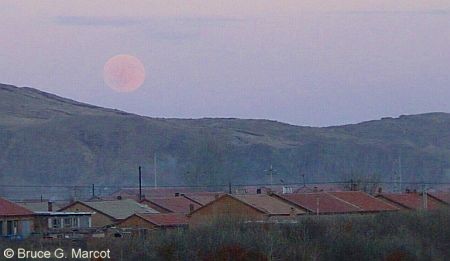Back to The Plexus Home Page
Human and Ecological Communities of Inner Mongolia, China: A System in Stress
Text and Photos
by Bruce G. Marcot
A part of the People's Republic of China, the natural world of the Inner Mongolia Autonomous Region or Nei Mongol on the Chinese maps, has been suffering immense degradation in recent decades. Here is a brief summary of the relation between the people and their natural environment -- in particular, the influence of human activities on the environment; how recent environmental degradation is causing social, economic, and ecological problems; and some potential solutions, yet to be realized.
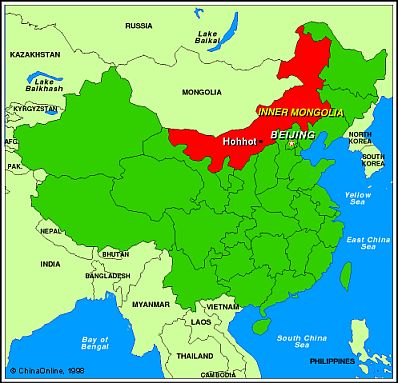
In recent times, much of the grazing land of Inner Mongolia -- once fertile with perennial grasses, woodlands, and wetlands – has been greatly overgrazed and overharvested.
What remains today, in many locations, are extremely desertified conditions -- human-caused deserts. The solution to restoring the land, however, is not just one of stabilizing the soil and bringing back native plants.
Also to be considered in any solution are the historic and current conditions of human cultures, land use traditions, and natural and human-caused environmental changes. The ramifications of desertifying portions of Inner Mongolia has touched all of these elements.
In 2002 I traveled to Inner Mongolia and principally to one of its most affected areas, Chifeng League (District), and studied the environment problems and possible solutions.
What Are the Major Problems?
1. What is the current problem of desertification in Inner Mongolia and Chifeng City?
-
Inner Mongolia is suffering from loss of soil fertility and productivity due to overuse, and many areas are severely degraded. Loss of soil productivity means human and ecological communities have suffered.
-
In the area of 90,021 km² in Chifeng city (district), the area of soil erosion was 10,820 km² in 1958; 17,839 km² in 1975; and 21,139 km² in 1984. This increase causes damage to the ecological community in this region.
-
Associated problems include overgrazing, habitat degradation, loss of native wildlife and forests, decrease in native wetlands, sandstorms, human poverty, overpopulation, lack of a diverse economic base, lack of education on the problem and its solutions, and a lack of scientific studies.
-
Causes of these problems include human activities, natural forest loss, overuse of water, increasing consumer demands, lack of economic diversity, mistaken government policies, loss of traditional cultural knowledge, changes in grazing patterns, and lack of implementation of existing land and resource use plans.
-
The region is ecologically important for its remaining (and vanishing) native wetlands, grasslands, and forests, and because it is the crossroads of 3 major floras (Mongolian Flora, Northern Flora, and Northeastern China Flora).
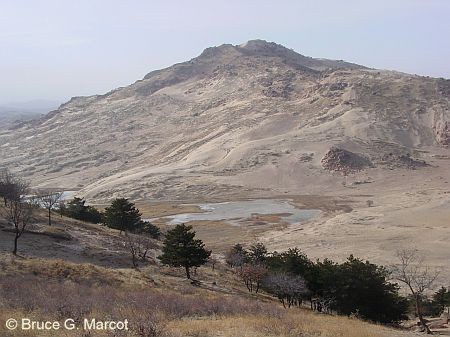
An increasingly scarce species of pine
(Pinus tabulaeformis) is being threatened by massive sand dunes
that engulf entire mountain peaks.
2. How are people and wildlife being affected by desertification?
- Desertification of the soil has had major impact on aboriginal Mongolian
and Chinese cultures of the region by severely reducing their production
of livestock, fodder, and agricultural crops, thus imposing increasingly
severe economic hardships on these people.
- Significant amounts of topsoil are lost every year when spring and
summer winds loft large areas of topsoil into the air.
- Such wind erosion causes major dust storms in Beijing and other distant
locations.
- Much of the native plants and animals of the region
has been reduced or eliminated by direct exploitation or by habitat loss,
and now occur mostly with in the small reserves and parks of the area.
- Wildlife adversely affected by this desertification
include the mammals Mongolian gazelle, Ussurian moose, and Siberian roe
deer; the birds white-naped crane, great bustard, reed parrotbill, and
relict gull; and many other mammals and birds also closely associated with
native grasslands and wetlands of the region.
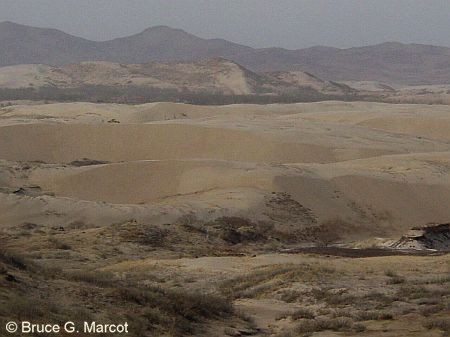
What was once lush native grassland is now shifting
sand.
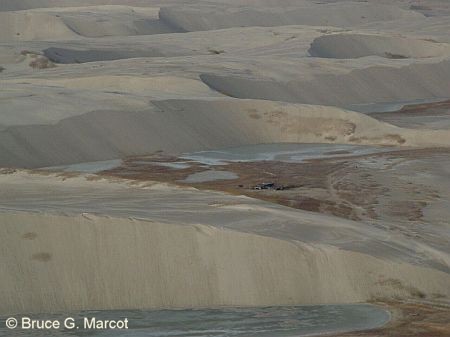
Barely visible among these massive sand
dunes created from desertification is an abandoned homestead in the center
of this picture.
3. What interest does the government of PRC have in rectifying this problem?
- PRC and Inner Mongolia Autonomous Region have been trying various
means to stabilize areas with highly desertified soil.
- PRC wants to rectify this problem in time for their hosting the Summer
Olympics in 2008.
- Also important in any conservation program for the region is attending
to the tradition of the minority groups of the region, including Mongolian
herders. They have occupied the region for thousands of years in
a sustainable balance with natural conditions, and may have much to teach
about long-term ecological protection.
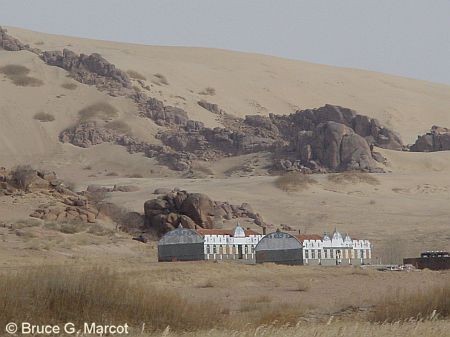
This tourism center is under attack from
massive sand dunes created by desertification and overgrazing.
4. What is the recent history of land use and wildlife habitats in Inner Mongolia?
- In contrast to most of their history of land use, in recent decades
Mongolian herders have been occupying permanent settlements on the edges
of remaining forest patches, and thus graze those nearby lands year-round.
This poses a far greater stress on the soil and vegetation than their previous
nomadic lifestyle provide.
- Because of extensive, recent deforestation of the region, they also are forced to remove much livestock dung for use as a fuel source during the frigid winters. This removes one possible source of nutrients for the soil.
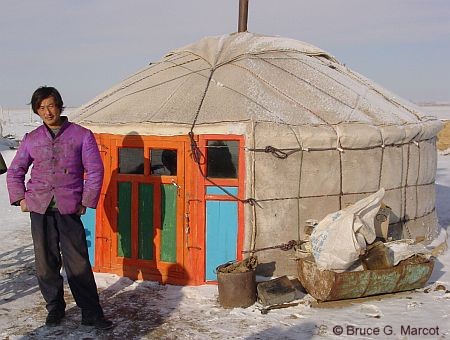
A local Mongolian herder by his traditional
yurt
hut made of dense wool and hide.
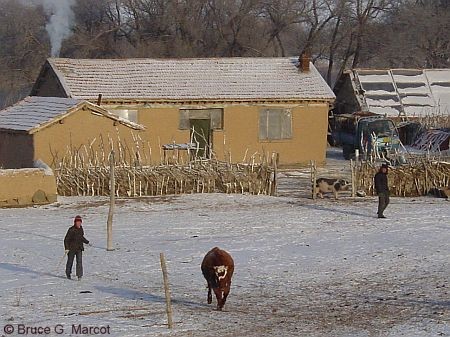
5. What is the ancient history of land use and wildlife habitats in Inner Mongolia?
- The inland wetlands and lakes of the region were once far more
extensive,
and likely harbored far greater populations of wetland wildlife, including
cranes, geese, ducks, and other species.
- Still existing in the area is a portion of the little-known “Great
Wall” of the Jin Dynasty, built by the Chinese 700-800 years ago to keep
out the invading Mongols. The wall is 10,000 km long, and is longer
than the more famous Great Wall just north of Beijing. The area thus
had been occupied be migrations and invasions of various peoples over the
centuries.
- The region likely was once covered by woodlands and harbored wild
horses, deer, antelope, and even tigers. This is evidenced by ancient
petroglyphs in the area dating 1,000-3,000 years old.
- The main lesson
from these markings -- as well as from many other historic relics of human
activities such as the petrology in Zhanzishan Mountain, the Great Wall
of the Jin Dynasty, and the capital relics of the last emporer in the Yuan
Dynasty – is that the prehistoric and early historic natural environment
was vastly different than today, likely with lush grasslands, much available
water, and more extensive forests. Such valuable natural resources
were the focus for some of the wars and battles in the region.
- During the last 50 years, this region has undergone
a rapid ecological change, largely due to overpopulation, overgrazing,
agricultural development of the native grasslands, and deforestation.
The ecological environment in this region has been rapidly degraded.
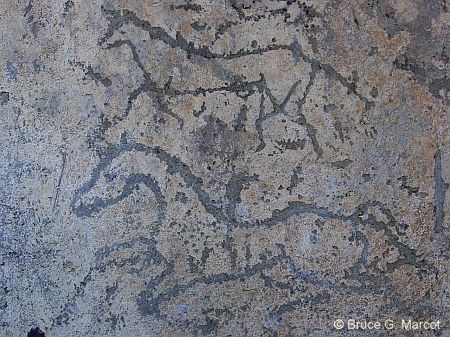
Ancient petroglyphs of wild horses, found
on a rocky outcrop in the region. These and petroglyphs of other
animals tell the story of habitats lost.
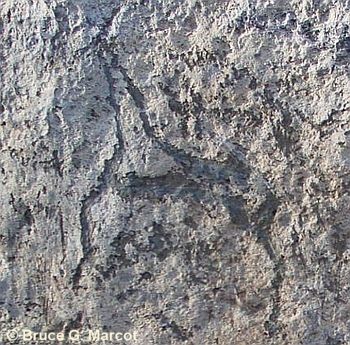
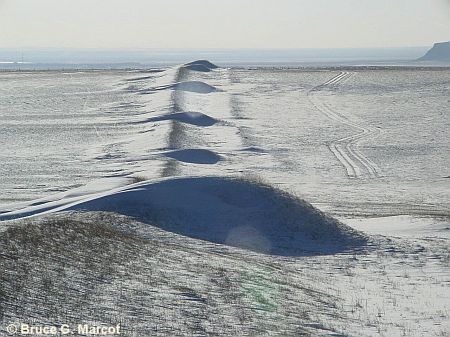
The seldom-seen Great Wall of the Jin Dynasty,
built 700-800 years ago to keep out Mongol invaders. Soldiers occupied
the towers along the wall, which were spaced at twice the distance an arrow
could be accurately shot.
6. What is currently being done to reduce
the spread of, and restore, desertified land there?
- The National and Regional governments are attempting tree-planting
in grids to help stabilize small areas of depleted, sandy soil.
- They are also trying to initiate a major new restoration and conservation
project that would address all social, cultural, and ecological dimensions
of the problem.
- A special technical workshop was held November 2002, on “Ecosystem
Protection and Sustainable Development, Chifeng, Inner Mongolia, China”
to discuss issues, problems, and potential solutions.
- The workshop
concluded that the best solution lies in an interdisciplinary and interagency
approach to restoration, conservation, and further economic development
of the region.
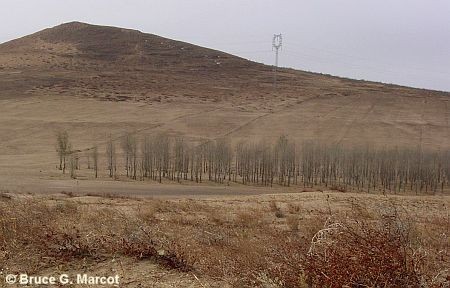
Deciduous hardwood trees planted in a tight
grid in an attempt to help stabilize soil and intercept the wind to reduce
wind erosion.
7. What portions of Inner Mongolia still have viable wetland and grasslands for use by wildlife and for grazing? What are they like?
- Inner Mongolia still harbors some global gems of wetlands and forest
reserves, particularly Baiyinaobao Nature Reserve, Dalai Nur Nature Reserve,
and in an adjacent district, Xilingol Biosphere Reserve.
- The value of studying places like Dalai Nur is to understand how natural
changes have also occurred over longer time periods. |
- Dalai Nur has
undergone dramatic geologic changes over thousands of years, including
periods of volcanism, continental drift, ice ages, and warming periods.
One can see multiple, ancient shorelines of the lakes, which have grown
and shrunk many times due natural climate changes. This has created
a diverse ecological system in the region.
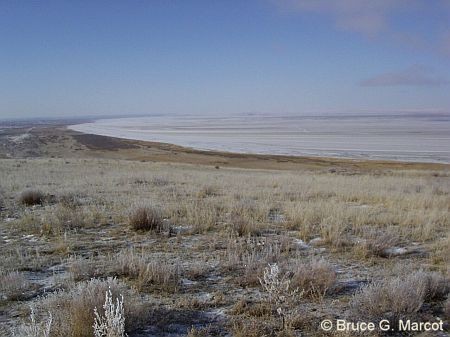
The natural gem of Dalai Nur
Lake, with
native (frozen) wetlands and grasslands.
8. What lessons can be learned from these areas for the future of ensuring long-term, sustainable use, and restoration of native ecosystems, of the region?
- These reserves can serve as benchmarks by which to measure the degree
of change that has happened outside their boundaries.
- Studying the plants, animals, and ecological processed within these
reserves can teach us the limits of productivity of the land, helping land
and resource managers to set realistic limits to agricultural, grazing,
and other resource uses, for long-term sustainability.
- These reserves also teach the value of retaining undisturbed natural
areas for human enjoyment, replenishment of the human spirit, and conservation
of wildlife, vegetation, and native ecosystems for future generations.
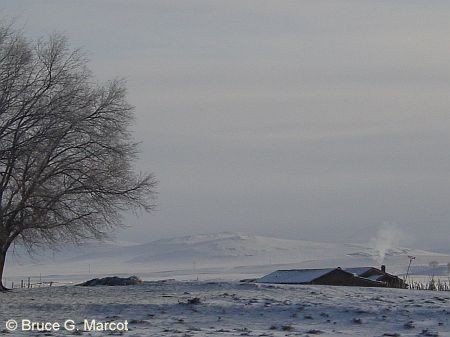
A frozen homestead of Mongolians in the middle of Inner Mongolia.
9. What is the answer?
Clearly, the existing natural reserves of the region and adjacent areas have much to teach.
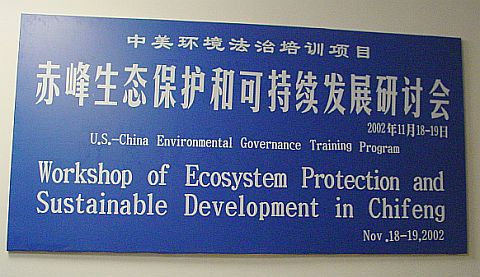
Elements of a comprehensive solution also should include the following (as derived from the 11/02 workshop):
- reduce overgrazing
- confer regulatory authority to the local ecological protection bureau
- learn by doing and testing (“adaptive management” approach)
- base policy on research
- promote restructuring of the regional economy toward sustainable land and resource use
- balance resource use, habitat conservation, and restoration
- educate the public
- fight poverty
- increase government ability to make scientific policies
- improve legislation on environmental protection
- expand the democratic basis of decision-making to include local people, and protect this under a system that defines the authorities under rule of law.

Back to the Ecology Plexus Page
Back to The Plexus Home Page
